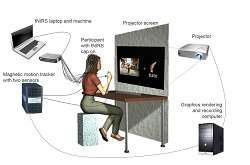A virtual reality approach to social interaction

People tend to copy other people's behaviour, facial expressions or speech when socially interacting with them. Understanding this unintentional mimicry using sophisticated technology was the subject of the INTERHYTHM project.
The tendency of individuals to imitate postures and gestures during social interactions is known as behavioural mimicry. It is commonly believed that being mimicked will lead to liking and trusting the mimicker more but the neural mechanisms which detect being mimicked are not known.
Studying social interaction
The Marie Skłodowska-Curie individual fellowship grant INTERHYTHM was designed to address how the effects of mimicry are shaped by the movement factors that make up the "interpersonal dance of communication," like timing and similarity of actions, on both a behavioural and a neural level. The project used virtual reality (VR), motion tracking and functional near-infrared spectroscopy fNIRS to examine how participants respond to being mimicked. .
"We wanted to investigate the unique capacity of humans to navigate our social worlds,″ explains project coordinator Prof. Antonia Hamilton. Until recently, methodological constraints inherent in the nature of social interaction have hampered the studying of interpersonal coordination.
In light of new technological advancements, however, the INTERHYTHM fellow Dr. Alexandra Georgescu decided to study this phenomenon by combining behavioural and neuroimaging methods: VR, motion tracking and fNIRS. "VR can simulate naturalistic and complex real-world scenarios, yet offers systematic manipulability and tight experimental control," explains Dr. Georgescu. "Moreover, by using concurrent motion tracking, we can implement contingent stimuli and interactive elements in the VR scenario."
Innovative fNIRS methodology
Neuroimaging paradigms are rather limited in terms of how much they allow participants to engage with a social stimulus and participants are restricted in the movements they can make in order to prevent artifacts in the recording of neural data. However, fNIRS is a neuroimaging technique that is much less susceptible to motion artifacts compared to other methods. It uses near-infrared light to monitor brain activity by measuring the haemoglobin concentration changes. This provides an estimate of oxygenation and haemodynamic changes associated with brain activity. The technology is portable and lightweight, offering an attractive means of monitoring a wide range of cognitive tasks such as social interaction.
The project built on existing neuroimaging data for mimicry that point towards mirror neuron systems, brain regions for self-other processing and reward-related systems. Results from two fNIRS experiments show that the inferior parietal lobule, a region involved in self-other differentiation is engaged during processing of the systematic manipulations of the factors. The paradigm could be used in the future to investigate these processes in individuals with autism spectrum disorder (ASD), which is a neurodevelopmental condition affecting social and communication skills.
Apart from laying the groundwork for adopting more naturalistic paradigms in the study of social interaction, INTERHYTHM will help formulate a better scientific theory of how we understand and respond to other people.
Prof. Hamilton envisages this "to have benefits for many fields, including helping children who struggle with social interaction and enhancing learning by imitation.″ Long term, the information generated during the project could help build better social robots to interact with people.
Provided by CORDIS





















